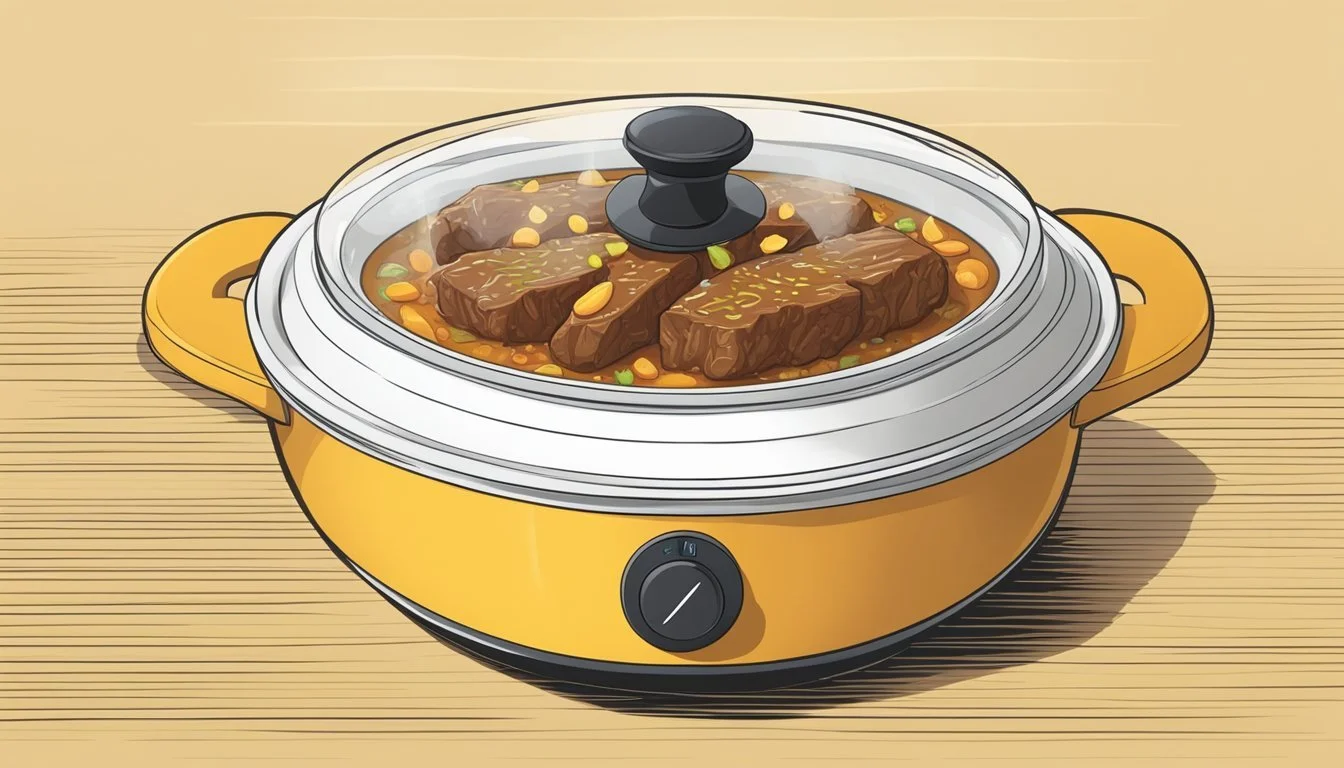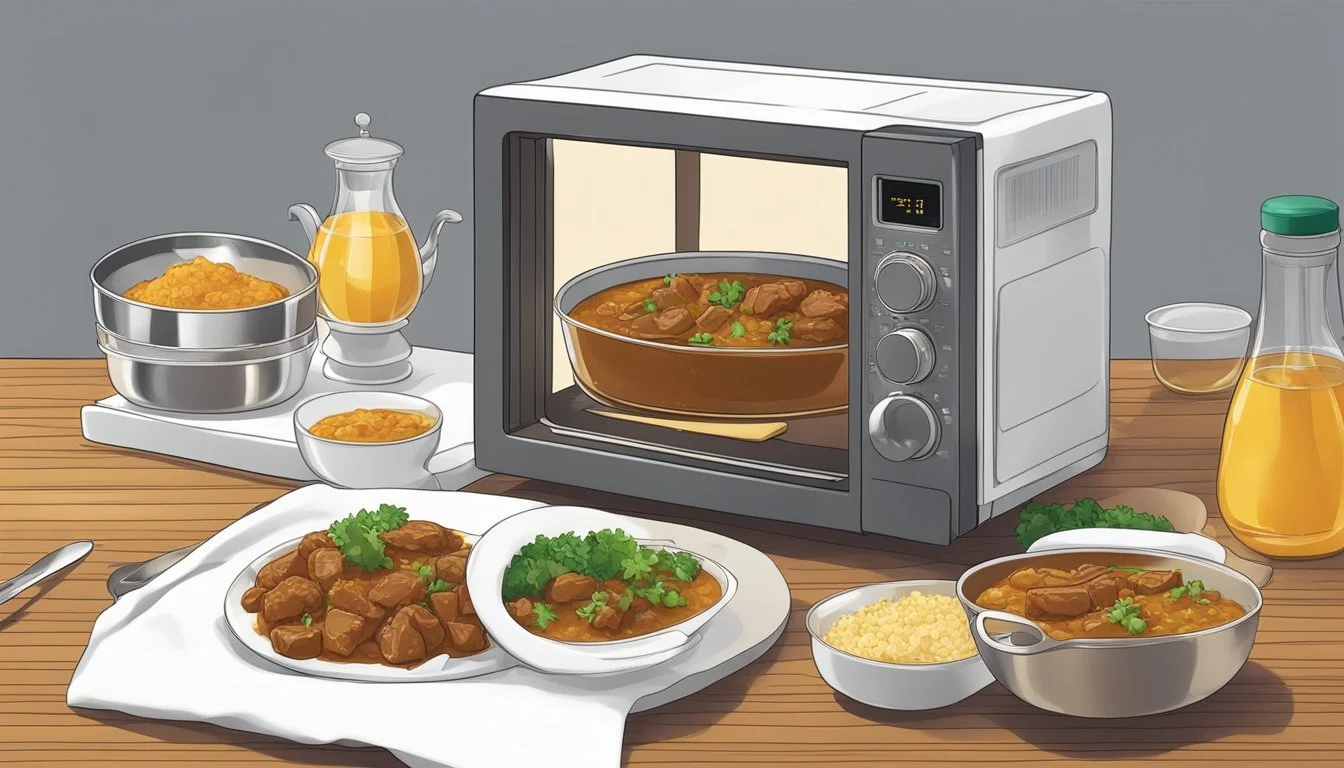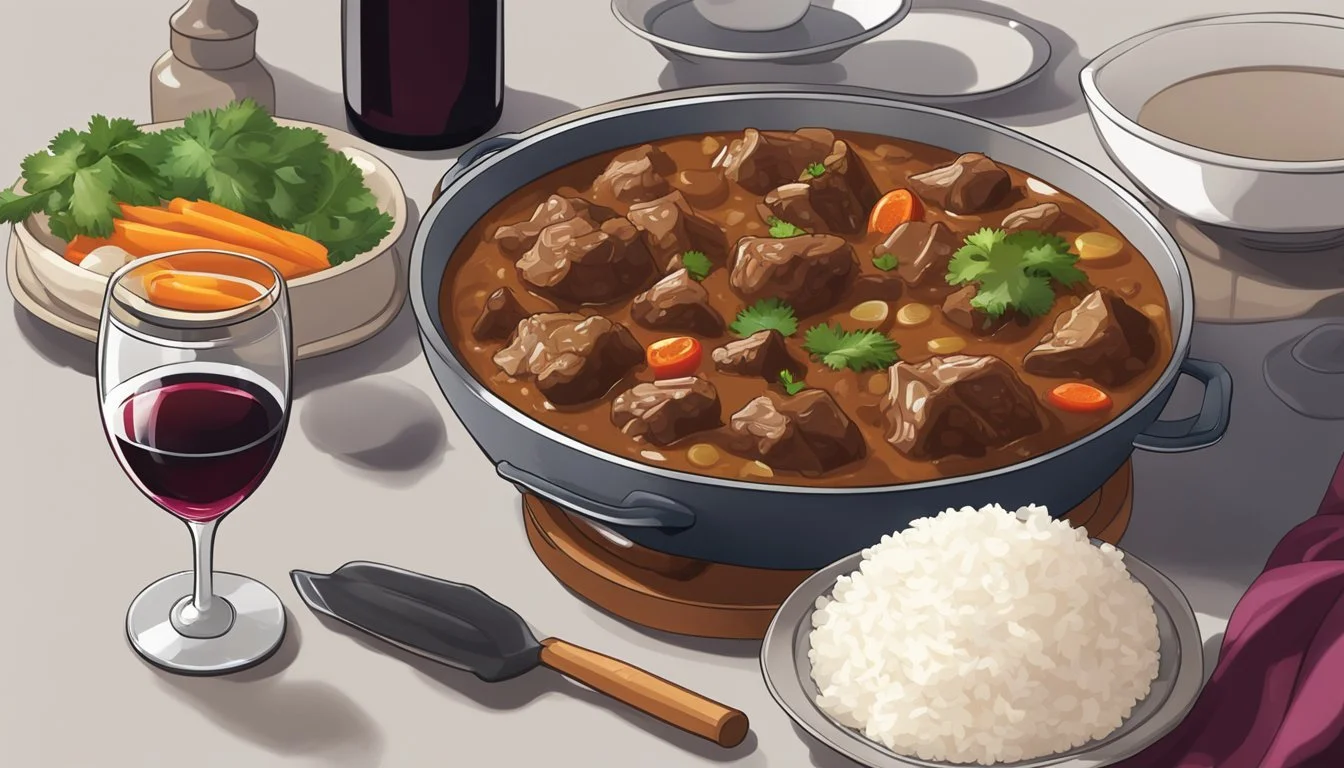How to Reheat Beef Curry
Best Methods and Tips
Reheating beef curry can be a quick and satisfying way to enjoy leftovers without compromising on flavor or texture. The best method to reheat beef curry is in the oven, where gentle, even heating prevents the meat from drying out and keeps the sauce rich and flavorful. Preheat the oven to 350°F (180°C), spoon the curry into an oven-safe dish, add a bit of water or stock to keep it moist, cover with foil, and heat for 15-20 minutes.
Using the stovetop is another effective option for reheating beef curry. Place the curry in a saucepan over medium-low heat, stirring occasionally until it's warmed through. This method allows for careful monitoring, ensuring that the curry heats evenly and retains its delicious taste.
Microwaving is the fastest approach, ideal for those in a rush. Transfer the curry to a microwave-safe bowl, cover it loosely, and heat on medium power, stirring every couple of minutes. This helps prevent uneven heating and keeps the beef tender. With these methods, your leftover beef curry will taste just as delicious as when it was freshly made.
Understanding Beef Curry Reheating Fundamentals
Reheating beef curry requires careful attention to safety and quality. Proper reheating methods ensure that the dish remains delicious and safe for consumption without compromising taste, flavor, or texture.
Importance of Reheating Safety
Reheating beef curry properly is essential to avoid foodborne illnesses. Leftover curry must be heated to an internal temperature of at least 165°F (74°C) to kill harmful bacteria. Use a food thermometer to check the internal temperature.
Thaw frozen curry in the refrigerator overnight before reheating to ensure even heating. Avoid reheating leftovers more than once, as this increases the risk of bacteria growth. Always store leftovers in airtight containers and refrigerate promptly.
Flavor and Texture Preservation
Maintaining the flavor and texture of beef curry when reheating is critical for an enjoyable meal. Use the oven for optimal results. Preheat to 350°F (175°C), transfer the curry to an oven-safe dish, and cover with foil to retain moisture.
Consider adding a small amount of water or stock if the curry appears thick. Stirring occasionally during reheating ensures even heat distribution. Avoid microwaving, as it can lead to uneven heating and affect the curry's texture.
Pre-Reheating Steps
Before reheating beef curry, it is essential to ensure the leftovers are safe to eat and properly prepared for the reheating process. This involves assessing the condition of the curry and taking preliminary steps to preserve its quality.
Assessing Leftover Beef Curry
To begin, inspect the beef curry for any signs of spoilage. This includes checking for unusual odors, discoloration, or mold growth. Leftovers should have been stored in an airtight container in the fridge to maintain freshness.
Leftover curry should ideally be consumed within 3-4 days of refrigeration. If it looks or smells off, it's better to discard it. Using a clean spoon to give it a gentle stir will help distribute any settled ingredients and provide a better idea of its condition.
Preparatory Measures Before Reheating
Remove the curry from the fridge approximately 15 minutes before reheating. This helps it reach room temperature gradually, which leads to more even heating.
Transfer the curry into an appropriate oven-safe dish, if you plan to use an oven, and add a small amount of water or broth to thin down the sauce if it has thickened. Cover the dish tightly with foil to retain moisture.
If using stovetop methods, place the curry in a saucepan over medium-low heat, stirring occasionally. Using a microwave-safe container for microwaving is also crucial, with intermittent stirring to ensure even reheating.
Reheating Beef Curry on the Stovetop
Reheating beef curry on the stovetop ensures even heat distribution and helps maintain the dish's rich flavors and textures. By following these methods, you can enjoy your curry as deliciously as it was initially cooked.
Using a Saucepan or Skillet
Selecting the right cookware is essential for reheating beef curry effectively. Saucepans or skillets are ideal due to their capabilities of retaining and distributing heat evenly. A covered pot or skillet helps to maintain moisture.
To prepare:
Choose a saucepan or skillet large enough to hold the curry without overcrowding.
Ensure the pot or pan is clean and dry before use.
Have a lid or foil ready to cover the cookware.
Stovetop Reheating Technique
Place the curry in the saucepan or skillet. Add a small amount of liquid (water, broth, or milk) to prevent the curry from becoming too thick.
Steps:
Set the stove to medium-low heat.
Simmer the curry and stir occasionally, ensuring even heat distribution.
Monitor the spices and flavors as the liquid reduces and the curry thickens.
Reheat for about 10-15 minutes or until the curry is thoroughly hot, reaching a safe internal temperature.
Avoid boiling to preserve the texture and flavors. Adjust seasoning if needed.
Reheating Beef Curry in the Microwave
Ensuring beef curry retains its flavor and texture during microwave reheating involves proper preparation and methodical steps. These guidelines provide easy-to-follow steps to achieve a well-heated, delicious meal.
Preparing Curry for Microwave Reheating
Before reheating beef curry, transfer it to a microwave-safe container. If there's insufficient liquid, add a tablespoon or two of water or broth to prevent drying out. Ensure the container is only partially filled to avoid spills.
Cover the container with a microwave-safe lid or plastic wrap. If using wrap, leave a small vent to allow steam to escape. Stirring the curry before reheating helps distribute flavors and spices evenly.
It's crucial to discard any aluminum foil wrapping as it is not microwave-safe. Using appropriate containers and covers helps maintain the quality and safety of the food.
Microwave Reheating Method
Set the microwave to low heat (around 50% power) to avoid overheating the curry. Begin by heating the curry for 60 seconds. After the initial minute, stir the beef curry thoroughly.
Continue reheating in 30-second intervals, stirring each time. This method ensures even heating throughout the dish. Be cautious and check after each interval to prevent overcooking.
Once the beef curry is piping hot and reaches an internal temperature of 165°F (74°C), it's ready to serve. Proper stirring and interval heating are key to an enjoyable and well-reheated beef curry.
These steps will help retain the meal's original flavors and texture while ensuring it is safely reheated.
Using an Oven for Reheating Beef Curry
Reheating beef curry in an oven ensures even heating and retains the dish’s flavors. Below are the preparations and optimal procedures for reheating beef curry using an oven effectively.
Oven Reheating Preparations
Start by preheating the oven to 350°F (175°C). This temperature allows gradual reheating without overcooking the beef.
Transfer the beef curry into an oven-safe dish. It's crucial to select a dish that can withstand high temperatures. Cover the dish with aluminum foil to prevent the curry from drying out.
Place the dish on the middle rack where the heat distribution is most even. Set aside a bit of water or broth to add if the curry appears too thick. This step keeps the curry's consistency just right.
Optimal Oven Reheating Procedure
Put the covered dish into the preheated oven. Warm the curry for about 20 minutes, ensuring it heats evenly. Halfway through the reheating process, stir the curry to distribute heat and moisture across all portions.
Continue reheating until the curry is piping hot all the way through. Check the temperature with a food thermometer to ensure it reaches 165°F (74°C), which is important for food safety.
Once finished, carefully remove the dish from the oven and let it sit for a minute before serving. This brief rest allows the flavors to settle and ensures the curry’s optimal taste.
Alternative Reheating Methods
There are several alternative methods to reheat beef curry that ensure it retains its rich flavors and textures. These methods include using a slow cooker and a steamer, both of which offer unique benefits.
Reheating in a Slow Cooker
Using a slow cooker is an excellent way to reheat beef curry, especially if you have a few hours to spare. The slow, even heat helps maintain the dish's integrity without drying it out.
First, transfer the curry to the slow cooker. Set the slow cooker to low; if you’re in a hurry, the high setting can also be used but requires careful monitoring. Add a little broth or water to the curry to ensure it doesn’t dry out during reheating.
Stir the curry occasionally to distribute the heat evenly. This gentle reheating method is perfect for preventing the separation of the sauce and keeping the meat tender and juicy. It typically takes 2-3 hours on low (or 1-2 hours on high) to fully reheat the curry.
Using a Steamer
A steamer provides another effective method for reheating beef curry, particularly useful for retaining moisture and flavor. Here’s how to do it:
Fill the steamer’s base with water and bring it to a boil. Place the curry in a heatproof bowl and set it in the steamer basket. Cover the steamer and allow it to heat for about 20-30 minutes.
Occasionally stir the curry to evenly distribute the heat. Adding a small amount of water or broth can help maintain the desired consistency. This method ensures the curry is evenly reheated without any risk of burning or overcooking, making it ideal for maintaining the dish's quality.
Serving and Pairing
When it comes to serving reheated beef curry, the right accompaniments and wine pairings can greatly enhance the dining experience. Here are some top suggestions to consider.
Accompaniments for Reheated Beef Curry
Reheated beef curry can be paired with steamed basmati rice to absorb the rich and flavorful sauce. Naan bread is another excellent choice, ideal for scooping up the curry and providing a different texture.
Adding a squeeze of lime to the curry can brighten the flavors and add a refreshing tang. A sprinkle of garam masala just before serving can revive and intensify the spices in the dish, making it taste freshly prepared. Including various chutneys or a simple cucumber raita can also balance the heat of the curry.
Wine Pairing Suggestions
Choosing the right wine is essential for complementing the spice and richness of beef curry. An Australian Shiraz pairs well with the robust flavors, offering bold fruit notes that complement the curry's heat.
Chilean Merlot is another good option, with its smooth and velvety texture offsetting the spiciness of the beef. For a more distinct pairing, a South African Pinotage provides earthy and smoky nuances that harmonize with the curry. Lastly, consider Rioja or Côtes du Rhône; both offer a balanced acidity and fruitiness that match well with the dish’s flavors.
Storing and Freezing Leftover Beef Curry
Leftover beef curry needs to be stored properly to maintain its flavor and prevent spoilage. There are key techniques for refrigerating and freezing to extend its shelf life effectively.
Proper Storage Techniques
Leftover beef curry should be cooled to room temperature before storing. Use airtight containers to prevent exposure to air and moisture, which can lead to spoilage. Store the curry in the fridge for up to 3-4 days. For best results, use glass containers to avoid staining. If separating curry from rice, store them in separate containers.
It's important to label the containers with the date they were stored. This helps in keeping track of freshness. When reheating the curry, make sure it reaches an internal temperature of at least 165°F (74°C) as measured by a food thermometer to ensure it's safe to eat.
Freezing and Thawing Curry
To freeze curry, transfer it to freezer bags or airtight containers, leaving some space at the top for expansion. Removing as much air as possible from freezer bags helps prevent freezer burn. Label the bags with the date before placing them in the freezer. Freezing can extend the shelf life to 2-3 months.
When ready to use, thaw frozen curry in the fridge overnight. Reheat it in a saucepan over low heat or in the oven, ensuring to stir occasionally. Avoid using the microwave for thawing as it can lead to uneven heating. Whether reheating or thawing, always ensure the curry reaches a minimum temperature of 165°F (74°C) for safety.
Tips and Tricks for Best Results
To ensure your beef curry is as delightful when reheated as it was when first prepared, focus on enhancing flavor and avoiding common mistakes.
Enhancing Flavor Post-Reheating
After reheating beef curry, consider adding fresh ingredients to brighten its taste. A splash of coconut milk or cream can make the dish notably creamier and richer. Additional spices like garam masala, coriander, cumin, or ginger can elevate flavors that may have mellowed.
Fresh garlic and coriander can provide a fresh, aromatic boost. Adjusting salt and pepper levels can bring out the flavors that might have dulled with time. Incorporate these carefully to avoid overpowering the dish.
Avoiding Common Reheating Mistakes
To maintain quality, thaw frozen curry in the refrigerator overnight, ensuring even heating. When reheating, do not overheat as it can dry the meat and sauce. Use a lid or tightly cover the dish with foil to retain moisture.
Stirring intermittently encourages even heating. Avoid reheating on high settings which can separate the sauce. Always check that the temperature reaches at least 165°F (74°C) to ensure safety and the best texture. Refrain from adding too much water, which can dilute the flavors.
Health and Nutrition Considerations
Reheating beef curry involves attention to health and nutrition considerations to ensure safety and flavor retention.
Bacteria and Food Poisoning
Reheat beef curry to an internal temperature of at least 165°F (74°C). This prevents harmful bacteria growth that can lead to food poisoning. Use a food thermometer to check.
Fresh Ingredients
Adding fresh ingredients like chilli flakes, fresh coriander, and peppers during reheating can enhance flavor and nutrition. These ingredients add vitamins and antioxidants, boosting the dish's nutritional profile.
Choosing the Right Oils
Reheat curry using olive oil. It is a healthy fat option that can elevate the dish's flavor profile while contributing beneficial monounsaturated fats.
Nutrition Facts
Here is a typical nutritional breakdown for one serving of reheated beef curry:
Nutrient Amount per serving Calories 350-400 Protein 25-30 grams Fats 20-25 grams Carbohydrates 30-35 grams
Food Safety Tips
Avoid reheating multiple times: This reduces the risk of bacteria buildup.
Stir regularly: Helps in even heating, reducing cold spots where bacteria can thrive.
Cover while reheating: Maintains moisture and helps heat distribute evenly.
Conclusion
Reheating beef curry can be straightforward with the right approach. Leftover curry often retains its flavors well, making it an ideal option for next-day meals.
When reheating curry, using a microwave, stovetop, or oven are all viable options. Stirring intermittently ensures even heating.
Microwave:
Place curry in a microwave-safe dish.
Heat on medium power in two-minute intervals.
Stir between intervals.
Stovetop:
Transfer curry to a saucepan.
Heat on medium, stirring occasionally.
Ensure it reaches a safe temperature.
Oven:
Preheat the oven to 350°F (175°C).
Place curry in an oven-safe dish.
Cover with foil and heat for 15-20 minutes.
Follow these guidelines to avoid common mistakes:
Thaw frozen curry in the refrigerator overnight.
Avoid overheating to prevent loss of texture.
Stirring is key for even heat distribution.
Reheating takeaway curry follows the same methods but may require adjusting times based on portion size.
Important Takeaways:
Ensure the curry is piping hot before consumption.
Reheating thoroughly kills any bacteria.
Proper storage extends the life of the curry.
By adhering to these straightforward steps, your reheated beef curry will be just as delightful the second time around.






